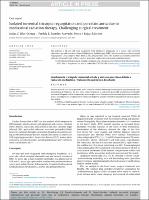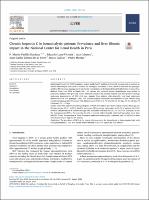Diagnostic performance of three non-invasive fibrosis scores (Hepamet, FIB-4, NAFLD fibrosis score) in NAFLD patients from a mixed Latin American population
Related Resource(s)
https://www.sciencedirect.com/science/article/pii/S1665268120301630Date
2020-11-01Author(s)
Zambrano-Huailla, Rommel
Guedes, Laura
Stefano, Jose Tadeu
de Souza, Arthur A. Arrais
Marciano, Sebastián
Yvamoto, Erika
Michalczuk, Matheus Truccolo
Vanni, Denise Siqueira
Rodriguez, Hernan
Carrilho, Flair Jose
Alvares-da-Silva, Mario Reis
Gadano, Adrian
Arrese, Marco
Miranda, Adelina Lozano
Oliveira, Claudia P.
Metadata
Show full item recordAbstract
Introduction and aims
Several non-invasive scoring systems have been developed and validated worldwide to predict the risk of liver fibrosis in nonalcoholic fatty liver disease (NAFLD). However, information about the performance of these systems in Latin American populations is scarce. Our aim was to evaluate the performance of the Hepamet Fibrosis Score, Fibrosis-4 (FIB-4) and the NAFLD Fibrosis Score (NFS) in a mixed Latin American group of NAFLD patients.
Methods
Clinical, laboratory and liver biopsy data collected from 379 biopsy-proven NAFLD patients from Latin American tertiary health centers were reviewed. Histological fibrosis stages were classified using the Kleiner score. Accuracy was determined, and new fibrosis score thresholds were calculated to better compare the performances of non-invasive tests and to explore their usefulness in excluding fibrosis.
Results
The distribution of fibrosis stages among the sample population was as follows: F0 (45%), F1 (27%), F2 (8%), F3 (16%) and F4 (4%). Using modified thresholds, the areas under the ROC curves (AUROC) for Hepamet and FIB-4 (0.73 and 0.74, respectively) to detect significant fibrosis were higher than that of NFS (0.58). However, the AUROCs of the three scores were not significantly different in advanced fibrosis and cirrhosis. To exclude fibrosis, we calculated lower cutoffs than standard thresholds for Hepamet, FIB-4 and NFS with similar performances.
Conclusion
Thresholds of non-invasive fibrosis scores (Hepamet, FIB-4 and NFS) can be modified to maximize diagnostic accuracy in Latin American patients with NAFLD.
Collections
- Artículos científicos [890]
Related items
Showing items related by title, author, creator and subject.
-
Dictamen Preliminar de Evaluación de Tecnología Sanitaria N° 020-DETS-IETSI-2022. Eficacia y seguridad de ataluren en pacientes con diagnóstico de distrofia muscular de Duchenne portadores de una mutación sin sentido en el gen de distrofina (actualización)
Seguro Social de Salud (EsSalud). Instituto de Evaluación de Tecnologías en Salud e Investigación (IETSI). Dirección de Evaluación de Tecnologías Sanitarias; Peña Sánchez, Eric Ricardo; Peralta Aguilar, Verónica Victoria; Zavala Loayza, José Alfredo; Rivera Ramirez, Paola Andrea (Seguro Social de Salud (EsSalud), 2022-04)Acceso abiertoEn este documento se plasma la evaluación de la eficacia y seguridad del uso del producto farmacéutico atauren en distrofia muscular de Duchenne portadores de una mutación sin sentido en el gen de distrofina; cuyos resultados ... -
Isolated torrential tricuspid regurgitation and porcelain aorta due to mediastinal radiation therapy. Challenging surgical treatment
Ríos-Ortega, Josías C.; Paredes-Acevedo, Freddy E.; Rojas-Sánchez, Pedro I. (Sociedad Española de Cirugía Cardiovascular y Endovascular, 2022-12-06)Acceso abiertoWe present a 64-year-old man diagnosed with Hodgkin's lymphoma at 3 years, who received chemotherapy and several sessions of Mediastinal Radiotherapy (MRT), which caused torrential tricuspid regurgitation (TR), complete ... -
Chronic hepatitis C in hemodialysis patients: Prevalence and liver fibrosis impact in the National Center for Renal Health in Peru
Padilla-Machaca, P. Martin; Luna-Victoria, Eduardo; Cabrera, Ada; Gómez De la Torre, Juan Carlos; Galloso, Rocio; Montes, Pedro (Ministry of Education of the People's Republic of China, 2022-09)Acceso abiertoBackground: Hepatitis C (HCV) remains a serious public health problem in high-risk persons such as patients on chronic hemodialysis. We aimed to estimate the serological prevalence of HCV, the HCV viral load and genotype, ...









